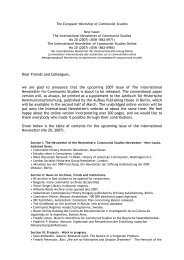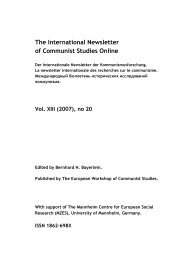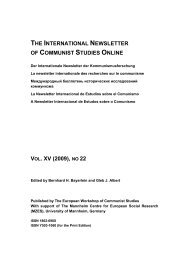The International Newsletter of Communist Studies Online IX
The International Newsletter of Communist Studies Online IX
The International Newsletter of Communist Studies Online IX
Create successful ePaper yourself
Turn your PDF publications into a flip-book with our unique Google optimized e-Paper software.
<strong>The</strong> <strong>International</strong> <strong>Newsletter</strong> <strong>of</strong> <strong>Communist</strong> <strong>Studies</strong> <strong>Online</strong> 16/2003 34<br />
necessity in Argentina at the moment <strong>of</strong> revolution. To a certain extent, these debates, unfortunately, are still as<br />
intense in today’s Argentina.<br />
Dorothea Melcher, Mérida, Venezuela: <strong>The</strong> Venezuelan Left and the Comintern<br />
<strong>The</strong> left-wing movement in Venezuela surged as the opposition to the dictatorial regime <strong>of</strong> Gomez (1908-1935).<br />
Mainly the students influenced by modernizing positivism and idealism were those who broadly accepted the<br />
democratic and social-democratic tendencies. Finally they were pushed into political exile in France, the United<br />
States <strong>of</strong> America, Central America, and in Spain, where their most radical sector established contacts with the<br />
Comintern through the All-American Anti-Imperialist League. Despite the fact that they composed the<br />
oppositionist slogans with social criticism, the movement maintained the traditional caudillist methods <strong>of</strong><br />
invasion and rebellion because the size <strong>of</strong> the working class at this time was very small and Venezuela’s<br />
population consisted mainly <strong>of</strong> poor peasants linked to caudillist groups. Thus, the ideological and political<br />
theories and concrete plans <strong>of</strong> the students led them to the necessity to separate from other opposition groups<br />
while their fidelity to the Comintern was camouflaged by their alliances with the conservatives. In the crucial<br />
year <strong>of</strong> 1929 two invasion movements were formed, though on the basis <strong>of</strong> different criteria. <strong>The</strong> left-wing<br />
invasion was planned despite Comintern objections, provoking a visible controversy with the Comintern<br />
representatives. <strong>The</strong> consequent failure <strong>of</strong> this attempt was transformed into the argument against their leaders<br />
during the process <strong>of</strong> Stalinization <strong>of</strong> the Third <strong>International</strong> when the Partido Revolucionario de Venezuela<br />
leaders were accused <strong>of</strong> not constructing the <strong>Communist</strong> Party <strong>of</strong> Venezuela as the revolutionary vanguard. <strong>The</strong><br />
CPV, founded only in 1931, with mainly Caracas militants, reflected the new political line taken by the<br />
Comintern. It was soon dismantled as the communist party activists were jailed or assassinated by the<br />
dictatorship. Later, the CP was reconstructed including the political forces <strong>of</strong> the exile during a constant<br />
process <strong>of</strong> rivalry between them, the <strong>Communist</strong>s inside the country and the Caribbean Bureau <strong>of</strong> the<br />
Comintern. As the CPV was a Stalinist party it found itself in political isolation while other left-wing groups<br />
emerged, mainly among the exiled students. Some cooperation with the <strong>Communist</strong> Party resulted from the<br />
new Popular Front policy decided in Moscow.<br />
Victor Kheyfetz, Dr. Lazar Kheyfetz, Institute <strong>of</strong> Latin America, Moscow: <strong>The</strong> Failure <strong>of</strong> a<br />
Continental Revolution – the First Steps <strong>of</strong> Mexican Communism, 1919–1922<br />
<strong>The</strong> creation <strong>of</strong> the Mexican communist movement in August-November 1919 was the result <strong>of</strong> both the<br />
internal development <strong>of</strong> the working-class movement <strong>of</strong> the country and the external influence exercised by<br />
the Comintern emissaries. After the split suffered by the <strong>Communist</strong> movement in the Fall <strong>of</strong> the same year and<br />
the emergence <strong>of</strong> the parallel Mexican <strong>Communist</strong> Party (headed by M. N. Roy, Ch. Phillips and J. Allen) and














